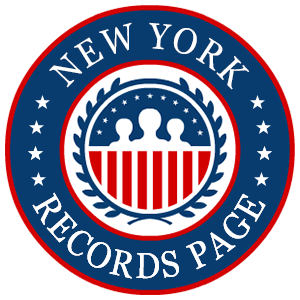Access free New York public records in no time via the databases, online search tools, and steps outlined in this streamlined resource.
These records are generally available to the public, thanks to state and federal public information laws, but knowing the offices that host these records and how to obtain each record type is important for a seamless and efficient lookup.
This article guides interested individuals through the process of tracking down the information they need on anybody in New York — including warrants, mugshots, convictions, arrests, background checks, court proceedings, and vital records.
New York Public Record Laws
Americans are free to request government records thanks to the Freedom of Information Act (FOIA). The New York’s Freedom of Information Law (FOIL) permits residents to ask for records, but they can’t be used in charity or sales situations.1
Some people track public records via third-party websites since many state and federal repositories cost money and may even require long-distance travel to obtain certain information. However, government sources usually possess up-to-date and reliable details about someone. All in all, individuals have to weigh the pros and cons of both before using the tools that suit their needs.
Furthermore, they must know how and where to search for the right jurisdiction, court, and documents.
New York Criminal Records
New York criminal records, commonly known as rap sheets, mainly contain misdemeanors or felonies, work history, incarceration records, and other imperative information. These details help prospective employers decide if someone can be trusted by the general public and their fellow colleagues.
Having a criminal record doesn’t automatically bar a person from a job, though. If the offense in question was of a petty manner, they may be given an opportunity for a fresh start.
Are Criminal Records Publicly Accessible in NY?
Criminal records are not entirely open to the public in New York, but court documents are generally accessible.
When obtaining New York public records — specifically criminal records — it is important to know that state law governs their accessibility.
Sealed records can only be accessed by the subject and authorized personnel. Additionally, criminal records in the possession of the New York State Division of Criminal Justice Services aren’t open to the public.2
How To Find New York Criminal Records
As mentioned earlier, criminal records held by the New York State Division of Criminal Justice Services (DCJS) aren’t considered public information.
Therefore, people can only retrieve their own criminal history reports through the bureau. (Employers and licensing agencies have to submit a Request for Access to Criminal History Record Information Form to view someone’s criminal history via the DCJS.)
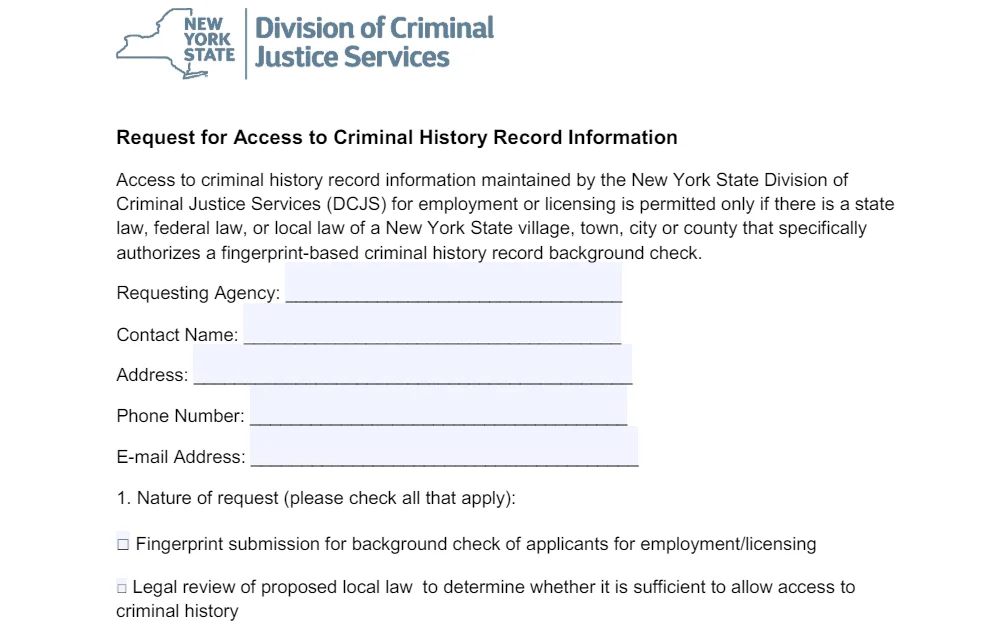
New York residents can request two types of records including suppressed or unsuppressed records. Suppressed records exclude expunged or sealed information and unsuppressed records include commonly sealed information such as certain juvenile offenses and acquittals.
Here are the procedures for obtaining criminal history records:
- In-State: They should set a fingerprinting appointment via IdentoGO online or by dialing (877)-472-6915. Then, they have to pay $13.50 in the form of a money order, check, or credit card. Patrons can’t pick up requests in person, so they need to wait for a response by mail, which takes about a month.
- Out-of-State: Those living outside New York need to use the IdentoGo website to pinpoint the nearest location to their home. Then, they attend their appointment and pay their fee of $43.50.
If there’s no IdentoGo facility in their area, they should print out a fingerprinting card to complete and take to their local police department.
Next, they sign up for Cardscan and pay $13.50. Once they complete their enrollment, individuals print out, sign, and mail the confirmation form and fingerprinting card to this address:
IdentoGo
CS Dept-New York
340 7 Springs Wy #250
Brentwood TN 37027
Those with questions or comments about conducting self-criminal history checks can contact the New York State DCJS by email at [email protected] or phone (518)-485-7675 or (518) 457-9847.
There is a place for interested parties to carry out criminal history checks on New Yorkers without special permission.
The New York State Unified Court System offers a Criminal History Record Search (CHRS) service for $95.00. Users can print out and send a CHRS application and payment to the New York State Office of Court Administration (OCA) or sign up for a Direct Access account.
People can sign up for a Public Account or a Corporate Account through the Direct Access website. Public Accounts lets users request up to five searches at a time and pay with a credit or debit card. Corporate Accounts are for those who used CHRS in the past, plus they can make payments via ACH and their credit/debit card.
Additionally, criminal history records can be found through various means, such as background checks, offender searches, and arrest records, which are discussed later in this guide. These records can also be obtained from local law enforcement agencies, including the county sheriff’s office and police departments.
Understanding the process of obtaining these records is essential for those individuals seeking access to arrest and criminal records in New York.
How To View Mugshots in NY State
A mugshot, an informal term for an arrest or inmate photo, enables the public to recognize and bring the subject to justice. However, New York limits public access to mugshots, and they’re not covered by FOIL.
This was done due to state budget cuts. But, people can still view them, albeit under certain circumstances. Police officers have to give valid reasons for releasing mugshots such as seeking assistance in hunting down an escapee.3
That said, there are resources residents can utilize to locate mugshots. The New York State Department of Corrections & Community Supervision (DOCCS) has a Most Wanted page listing absconder photos and their conviction information.
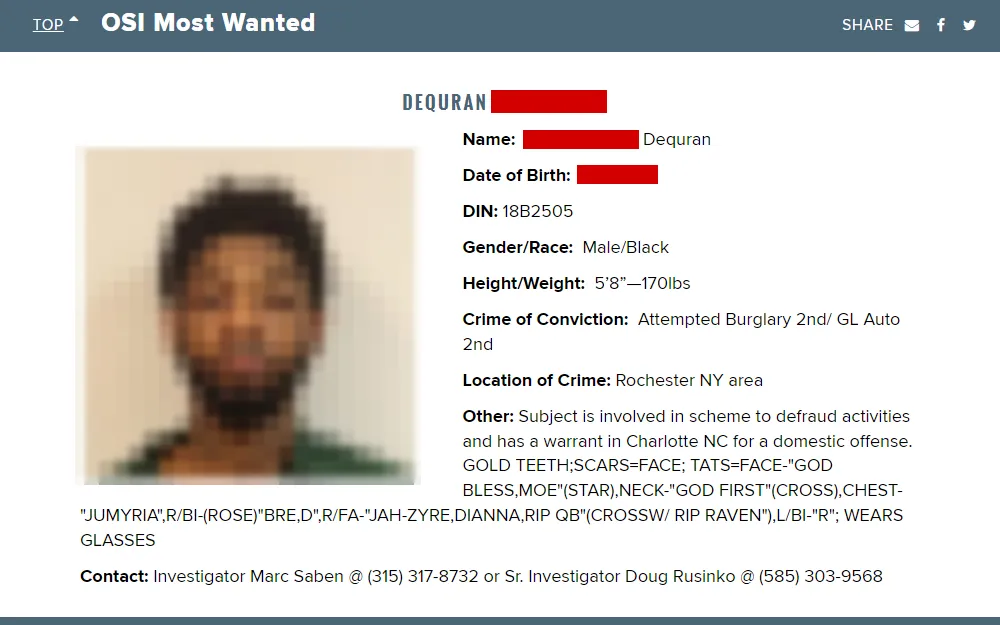
The FBI’s New York Wanted section features photos and details about suspects, missing people, and offenders.
Additionally, interested individuals can also view offender’s mugshots by visiting the specific department directly. This is because mugshots are considered public records in New York, and law enforcement agencies are required to make them available upon request.
Many news and radio websites also carry mugshots. Internet surfers can find them by typing “New York Most Wanted” into a search engine to bring up these results. People should even consider offline methods like TV news stations and newspapers.
New York Juvenile Records
Under the New York public records law, juvenile records are not accessible by the public.
The New York State Unified Court System splits kids who commit crimes between the ages of 7 and 18 into Juvenile Delinquents, Juvenile Offenders, Youthful Offenders, and Adolescent Offenders:
- Juvenile Delinquents — are children who are at least 7 years old but younger than 18. They don’t possess a criminal history record since their cases are private and overseen by the Family Court. They’re typically placed into treatment programs or supervised by social services.
- Juvenile Offenders — are between the ages of 13 and 15. If they’re found guilty of a severe crime, they’ll possess a criminal record. (However, the County or Supreme Court can consider them Youthful Offenders if appropriate.) They can even be brought over to the Family Court at a judge’s discretion and gain Juvenile Delinquent status.
- Youthful Offenders — are teens spared from the stigma of a lifelong criminal record. They’re between the ages of 14 and 19, and their Youthful Offender status has to be determined by the courts.
- Adolescent Offenders — have been convicted of felonies and are 16 or 17. If eligible, they can be brought over to the Family Court and be treated as Juvenile Delinquents.4
Note that none of the above are classified as adult offenders. Even though many states try some juveniles as adults based on the severity of their crimes, the Raise the Age (RTA) law mandates that they can’t be convicted as adults until they’re 18 years old.
The only people who have permission to view juvenile records are the juvenile, their parent(s) or guardian(s), and law personnel. Their cases are automatically sealed if they were tried as Juvenile Delinquents or Youthful Offenders.
Those who permission to access these records may contact Family Court or the court where the case was heard.
How Do I Find Out Who’s Wanted in New York? (Free NY Warrant Check)
If someone suspects they have a warrant out on them, they need to check as soon as possible whether it’s an arrest or bench warrant. That way, they can turn themselves in if necessary and save themselves from the humiliation of being arrested at home or in public.
New York warrant information can be obtained from the court who issued the warrant. The court clerk’s office may able to provide information about warrants via phone or visiting the office directly. Additionally, law enforcement agency, like sheriff’s office and police department can also provide limited details about the warrant status and relevant information.
How T0 Look Up Information on Sex Offenders in New York
The New York State Division of Criminal Justice System (DCJS) operates a Sex Offender Registry that includes Level 2 and Level 3 offenders. Level 2 offenders pose a medium risk, and Level 3 offenders present a high risk. Locals can even sign up for relocation alerts if a registered sex offender moves.
Site visitors can use the registry search to locate an offender by last name, county, or zip code. If they wish, they can narrow their search by clicking the boxes next to the words “Incarcerated,” “ICE Custody,” and “In Custody.” Each search result features an offender’s photo, address, risk level, and other pertinent details.
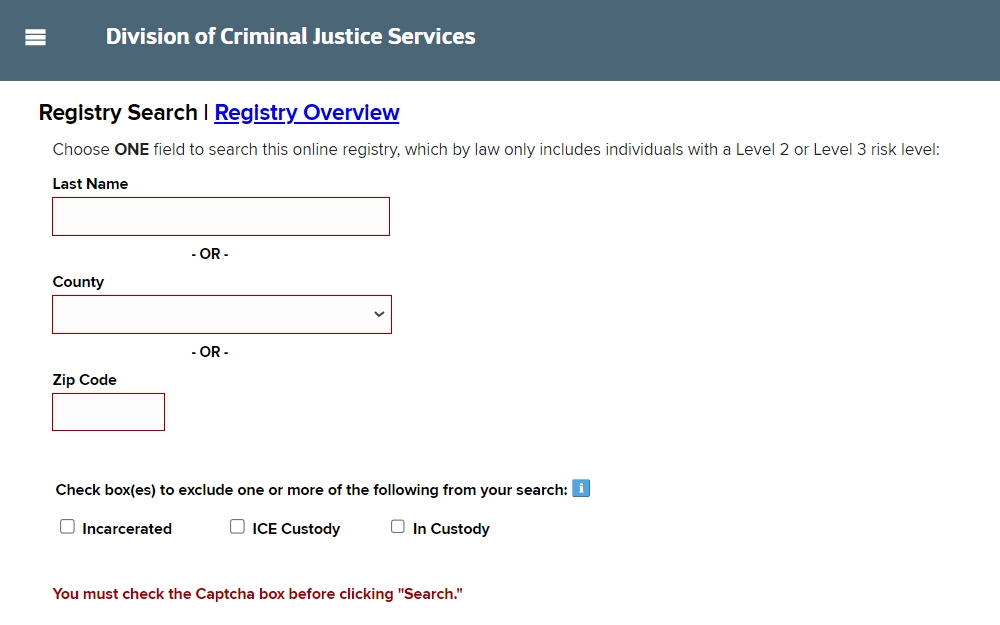
What’s interesting about this registry is that it has few residency restrictions. Individuals can conduct searches on offenders who live outside New York and even outside the United States.
How To Request & Perform a NY Background Check
Background checks are required for most jobs, especially ones related to security, the medical field, and even data entry. They’re also a necessity for other aspects of living like self-defense, loan applications, and apartment renting. What shows up on a typical background check includes an individual’s driving record, credit history, and court records.
Nevertheless, when it comes to background checks, New York handles them differently than many other states. Due to the Fair Chance Act, most employers can’t inquire about someone’s criminal background before bringing them on the job. They have to conduct a two-step background check, which requires them to carry out the reference, school, and other non-criminal checks before hiring them and checking an employee’s criminal past after they’re hired.5
With that said, individuals can use the tools and methods outlined in the criminal records section to carry out self-background checks for employment purposes or to get a new or updated professional license after being hired.
Individuals can request their own criminal history records from the New York Department of Criminal Justice Services (DCJS) by submitting a fingerprint. Another option is through the New York Justice Center’s Criminal Background Check.
People who want to sell or own guns have to abide by the rules dictated in the NY SAFE Act. Whether they want to apply for a license, renew a license, sell firearms, or register assault weapons, they need to print out and submit the required firearm license and certification forms.
Understanding New York Court Records
New York court records mainly consist of names of litigants, any property disputes, pending bench warrants, and other information. Some court records in this state are open to the public except those that are sealed or non-disclosed, such as records associated with custodial situations.
There are several trial and appellate courts that encompass New York State. Some of them operate in New York City while others work outside the city:
- New York City Trial Courts
- Trial courts deal with civil and criminal matters. Civil cases handle suits related to rental payment issues and small claims. Criminal cases involve petty offenses, misdemeanor, and felony hearings.
- Trial Courts Outside New York City
- County Courts have the same jurisdiction as Town, Village, and City courts in overseeing petty offense and misdemeanor cases. Additionally, they handle felony cases.
- Town or Village Justice Courts take care of arraignments of the accused before transferring them to the County Courts. They also deal with petty offenses and misdemeanor trials.
- City Courts handle civil suits associated with rent and housing disputes. Furthermore, they assist those sued for petty offenses, misdemeanors, or felonies.
- District Courts are based in five Suffolk County towns and Nassau County. Like the aforementioned courts, they help defendants involved with a petty offense, misdemeanor, or felony cases.
- Appellate Courts
- Appellate Terms of the Supreme Court listens to “second-chance” cases transferred from the criminal and civil courts of New York City and district, city, and town/village trial courts outside the city. The County Courts take on an appellate position for town, city, and village trials.
- Appellate Divisions handle criminal and civil appeals from trial courts and civil appeals from the County Courts and Appellate Terms of the Supreme Court.
- The Court of Appeals is the state’s equivalent to the Supreme Court. In addition to hearing out appeals cases from the lower courts, they create the rules lawyers need to abide by and review appeals trials related to judicial misconduct.
- Trial Courts In & Outside of New York City
- The Family Court deals with juvenile delinquency, child welfare, custody disputes, guardianship, and other family and/or child-related matters.
- The Supreme Court helps with trials associated with marriage dissolutions, felonies, and civil cases involving lots of money. In areas outside of New York City, County Courts listen to criminal trials, and Supreme Courts listen to civil trials.
- The Court of Claims handles cases related to money damages against locations in the state like the City University of New York and the New York State Thruway.
- The Surrogate’s Court works with estate matters, adoptions, and probate processes.
How Do I Look Up Court Cases Throughout New York?
Anyone interested in looking up a case about themselves or another person can utilize the tools offered by the New York State Unified Court System. It has an online repository that allows users to find local, supreme court, criminal, and family cases. They need information like attorney name and index name before starting their search.
Unfortunately, eCourts only carries non-confidential case information. Those interested in seeking private records—provided they have the legal authority to do so—should contact the county clerk or the clerk of the court where said records are located.
They can do this by visiting the New York State Courts page. To the left is a court locator where someone can select the county and/or choose the court type before clicking on “Find the Court.”
If site visitors need assistance related to court records or other judicial matters, they can contact the New York State Unified Court System by email, phone, or mail.
How To Obtain NY Bankruptcy Records
People searching for state bankruptcy records can find them in three different bankruptcy courts:
- New York North Bankruptcy Court
- Locations: Utica, Albany, Syracuse
- New York Southern Bankruptcy Court
- Locations: White Plains, Manhattan, Poughkeepsie
- New York Western Bankruptcy Court
- Locations: Rochester, Buffalo
Residents can visit any of them in person, but if they rather retrieve bankruptcy information from home, they can use McVCIS (Multiple-Court Voice Case Information System). They access the phone system by dialing 866-222-8029 (respective extensions 6261, 6262, and 6264). What’s convenient about this service is that it’s available 24/7, so it doesn’t interfere with anyone’s busy schedule.
The Public Access to Court Electronic Records (PACER) site is another convenient source since a person can conduct their research via their mobile device. It costs only $0.10 per page for digital documents. Those who qualify can even waive fees if they’re unable to pay them.
New York Inmate Records Explained
As of late, about 20,500 inmates dwell in New York jails. The state’s prison population is approximately 43,500.6
New York inmate records typically contain inmate demographic information, convictions, and correctional institutions. Law enforcement agencies and parole boards benefit from these details because they can see if an inmate is eligible for probation or early release.
How To Gain Insights on Someone Arrested & Held in a New York Jail
If someone is curious about the status of an arrestee or jail inmate, they can become a member of Victim Information & Notification Everyday (VINE). Through this website, people can track the custody status of inmates in city and county jails. It also offers services for crime victims.
In addition, residents can take the search engine route and locate a specific jail by researching the words “jail inmate search New York.” For example, the Cayuga County Sheriff’s Office provides a weekly report listing arrestees and their charge information. Some of them come with mugshots.
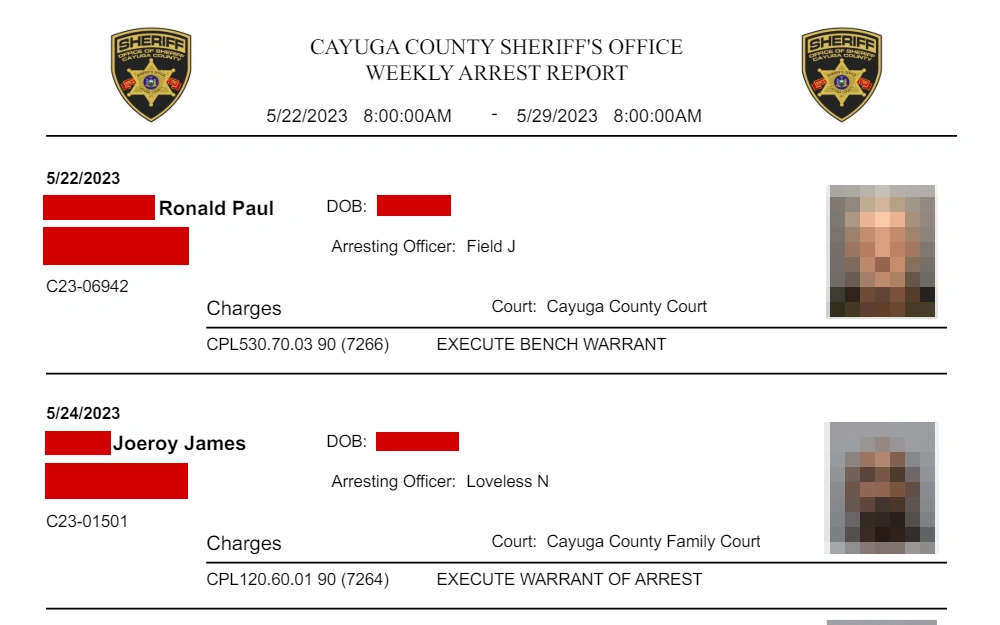
The New York City Department of Correction (DOC) provides an inmate lookup feature that allows others to find inmates in city jails within New York, Queens, Bronx, Kings, and Richmond counties only. Site visitors receive information like release dates, bond amounts, and NYSID (New York State Identification Number).
Residents can also obtain the phone number of the police department or county jail they pick from the search results and call them. Some police officers tell callers that the person they’re looking for has been in their custody for only a couple of days and has yet to stand trial.7
How To Search Details of New York State Prisoners
The New York State Department of Corrections & Community Supervision (DOCCS) has a prisoner search feature that allows users to find inmates by name, birth year, and DIN (Department ID Number).
Interested parties can find federal inmates at the Federal Bureau of Prisons (BOP). They can use the inmate locator or select from the prison locator list.
Sending Money to Individuals Incarcerated in New York City
The New York City Department of Corrections & Community Supervision (DOCCS) offers many funding options for family and friends to support their loved ones so they can afford hygiene products and other necessities. They can send money via MoneyGram and JPay:
- MoneyGram– Customers can visit a location closest to their home. Receive code is 1317.
- JPay– This provides four deposit methods including telephone, mail, online, and app.
- Telephone– Patrons have to dial (800)-574-5729 to send money with the help of customer service.
- Mail- People mail a money order or check along with a deposit form to JPay, P.O. Box 531190, Miami FL 33153. They can submit an English or Spanish deposit slip.
- Online– Web deposits can be made with a debit or credit card.
- App– Individuals can download the JPay app through Apple or Google Play and send deposits.
Deposit fees vary depending on the method utilized.
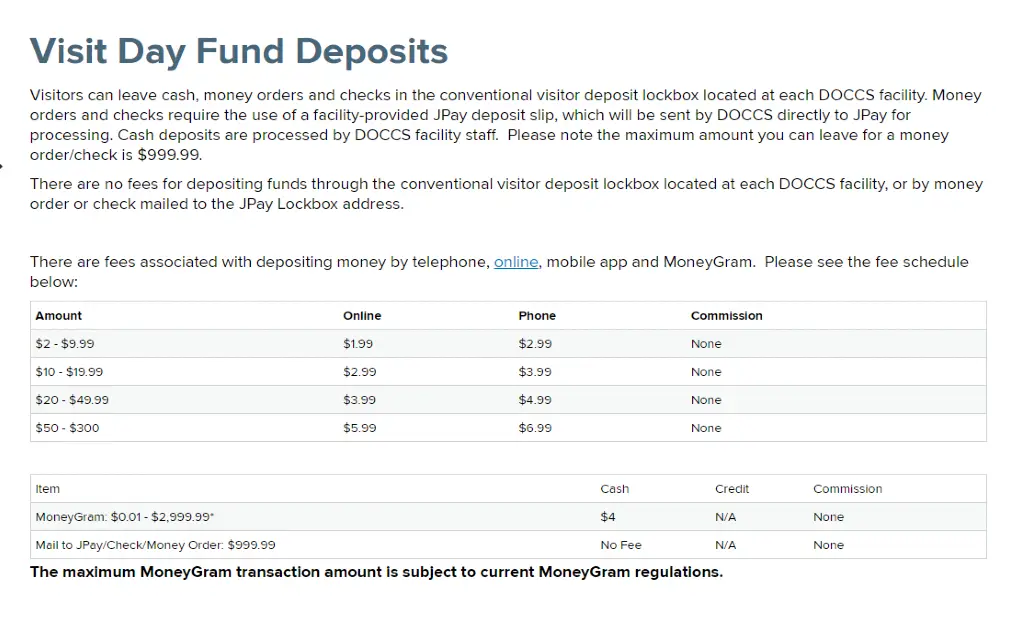
Prisoner Visitation
If anyone wants to visit a New York State DOCCS facility, they have to contact the specific first to get more information since each institution has its own visiting hours and days. Adult visitors have to bring valid government identification like a driver’s license or a state I.D. (For minor visitors, birth certificates suffice as valid identification.)
Before commencing their visit, people are required to sign a statement acknowledging their comprehension of the rules.
New York Vital Records (Birth, Death, Marital, Divorce)
Vital records in New York consist of fetal death and stillbirth certificates, pre-adoption certificates, marriage certificates, birth certificates, genealogy records, death certificates, and divorce certificates. This part of the article concentrates on the following:
- Death Certificates
- Divorce Certificates
- Marriage Certificates
- Birth Certificates
Can Anyone See New York Vital Records?
In New York, vital records include marriage, divorce, birth and death records. Access to these New York public records is restricted for a specified period. Technically, anyone can view vital records in the state, but only after a certain number of years passed.
For instance, birth certificates are not open to the public until they’re at least 75 years old. Death and marriage records have to be 50 years old or older before the general public can see them.8 Divorce decrees are sealed for a century.9
Find Out Who’s Married or Divorced in NY (Free Records)
Someone who is wondering about a person’s marital status has to meet certain criteria before they can access their marriage or divorce records. They either have to be the spouse of the subject or receive permission from the courts.
Although there are limitations as to who can access this information through the Vital Records, third-party search sites check government resources and other online sites like social media so they may have more information where access to vital records is restricted.
To give readers an idea of just how many people are divorced, the graph below shows New York’s divorce rates by county and based on the United States Census Bureau estimates over the past 5 years.
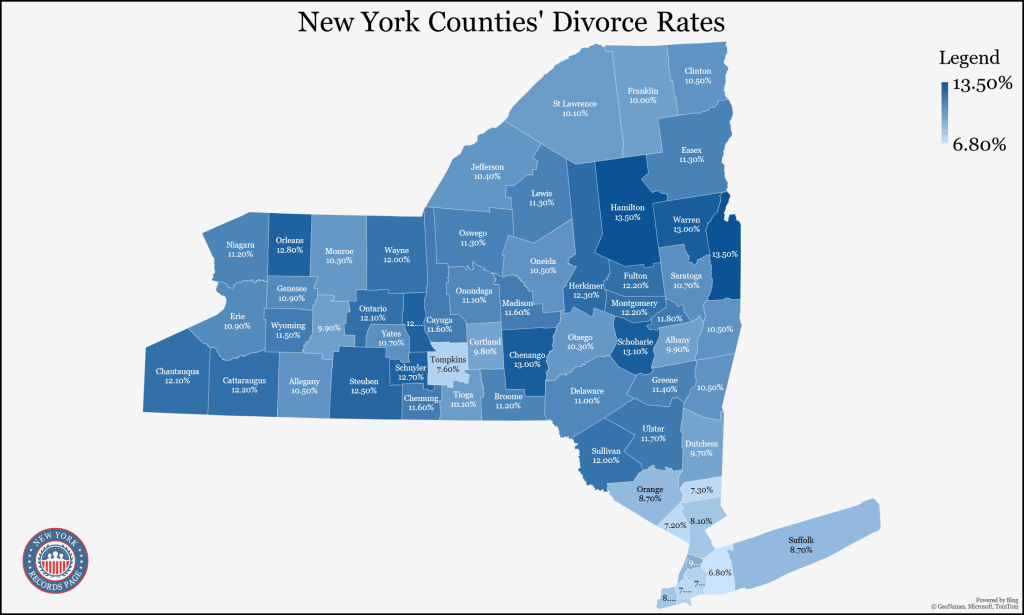
People can obtain New York marriage certificates and acquire NY divorce decrees or documents from the county where it occurred. They can also opt to purchase marriage and divorce certificates from the New York State Department of Health’s Vital Records Division.
Patrons can order marriage and divorce certificates by phone, online, or mail:
- Phone or Online– Customers can call VitalChek at (877)-854-4481 or order through its website.
New York State (DOH) – Vital Records
PO Box 2602
Albany NY 12220
Get a Replacement Birth Certificate or Copy of Death Certificate in New York City
To get a replacement birth or death certificate in New York, an individual has to be an immediate family member, a spouse, or a court-ordered representative. (A person has to be a legal adult to obtain their own birth certificate.)
Residents can order replacements either from the New York State DOH or the New York City Department of Health (DOH).
Birth or death certificates purchased from the New York State DOH have the same procedures as marriage and divorce certificates. Here are their mail-in forms:
New York City DOH orders can be placed via VitalChek, by mail, or in person. Below is the address and applications:
New York City DOH
Off. of Vital Rec.
125 Worth St. #144
NYC New York 10013
Furthermore, customers can book appointments online.
Hunting down government information can be a tricky business. However, once someone learns the ins and outs of it, they can gain the knowledge and the confidence in locating New York public records.
References
1New York FOIA Laws – National Freedom of Information Coalition. (n.d.). National Freedom of Information Coalition. Retrieved June 27, 2022, from <https://www.nfoic.org/new-york-foia-laws/>
2Freedom of Information Law (FOIL) Requests – NY DCJS. (n.d.). New York State Division of Criminal Justice Services. Retrieved June 27, 2022, from <https://www.criminaljustice.ny.gov/crimnet/foil.html>
3Mugshots Removed From Public Record In New York State. (2019, April 4). WICZ. Retrieved June 27, 2022, from <https://www.wicz.com/story/40255428/mugshots-removed-from-public-record-in-new-york-state>
4Crimes by Children | NY CourtHelp. (2019, December 23). Unified Court System. Retrieved June 27, 2022, from <https://nycourts.gov/Courthelp/Criminal/crimesbyChildren.shtml>
5Moshes, Y. (2022, January 8). New York Employment Background Check Law – NYC. Moshes Law. Retrieved June 27, 2022, from <https://mosheslaw.com/nyc-background-check/>
6New York 2019. (n.d.). National Institute of Corrections. Retrieved June 27, 2022, from <https://nicic.gov/state-statistics/2019/new-york-2019>
7Find an Arrested Person · NYC311. (n.d.). NYC 311. Retrieved June 27, 2022, from <https://portal.311.nyc.gov/article/?kanumber=KA-01399>
8(n.d.). YouTube. Retrieved June 27, 2022, from <https://www.nysl.nysed.gov/genealogy/vitrec>
9Are New York Divorce Records Public or Confidential? (2020, August 11). Berkman Bottger Newman & Schein. Retrieved June 27, 2022, from <https://www.berkbot.com/blog/2020/august/are-new-york-divorce-records-public-or-confident/>
10New York State Division of Criminal Justice Services (DCJS). (n.d.). Request for Access to Criminal History Record Information. Retrieved June 5, 2023, from <https://www.criminaljustice.ny.gov/ojis/documents/Request-for-CHRI-Access-Form.pdf>
11New York State Department of Corrections and Community Supervision. (2023). OSI Most Wanted. Retrieved June 5, 2023, from <https://doccs.ny.gov/osi-most-wanted>
12New York State Division of Criminal Justice Services (DCJS). (n.d.). Registry Search. Retrieved June 5, 2023, from <https://www.criminaljustice.ny.gov/SomsSUBDirectory/search_index.jsp>
13Cayuga County Sheriff’s Office. (2023). Arrest Blotter. Weekly Arrest Report. Retrieved June 5, 2023, from <https://www.cayugacounty.us/DocumentCenter/View/22750/Weekly-Arrest2023-05-29-08-15-57>
14New York State, Department of Corrections and Community Supervision. (2023). Account Deposits. Visit Day Fund Deposits. Retrieved June 5, 2023, from <https://doccs.ny.gov/account-deposits>
